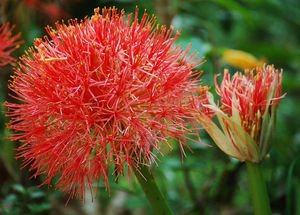Spider Lilies delicate, airy blooms explode in early autumn when summer comes to an end.
Spider Lilies are not true lilies but belong to the Lycoris genus, which is part of the Amaryllis family. Their large, striking blooms have curled back petals and stamens that give them their characteristic spidery appearance.
The flowers emerge on stiff, stalk-like stems in early autumn, seemingly popping up from the soil. The minimal foliage persists throughout winter and dies back in spring.
Golden Spider Lilies (L. aurea) grow 30 cm tall with clusters of golden-yellow flowers. The dainty, narrow petals curl back as numerous long, slender stamens reach out, imparting a wonderful exotic look.
The most delicate variety is the eye-catching Red Spider Lily (L. radiate). With ten to fifteen rose-red blooms with long stamens on 30-45 cm stems, it adds interest and color to warm-region gardens.
An unusual Spider Lily (L. squamigera) has trumpet-shaped, rose pink flowers and strap-like leaves. Although it looks different from the other Spider Lilies, it is in the same family group.
Spider Lilies are not fussy about whether thy are placed in the sun or shade, so use them freely anywhere your garden could do with a flourish of late-summer color.
In the perennial bed, plant Spider Lilies behind short, bushy plants that will conceal the bare planting site in summer but will not obscure the view when the Lilies burst forth with color.
Spider Lilies do well in containers. A 30cm tub is large enough for five bulbs and small enough to be portable. Move it to a prominent place when blooming begins, so that you can better appreciate its form and color.
Because Spider Lily bulbs tolerate partial shade and dry soil, they are perfect for planting at the edges of woodlands and along foundations. For a late-season burst of vibrant color above green foliage, try tucking some Spider Lily bulbs among groundcovers, such as Pachysandra or Erigeron.
If you have a shady spot in your backyard, plant Spider Lilies in the lawn. They will create a dramatic impact as they emerge through the lawn, which should have slowed its growth in autumn.
Many late-summer flowers bear full, rounded blooms on bushy plants. The tall, slender elegance of Spider Lilies provides a graceful, vertical counterpoint to such shrubs.
For a great effect, Spider Lilies are wonderful planted with Chrysanthemums. Pair ivory White Spider Lilies (L. albiflora) with pale yellow Chrysanthemum ‘Marion’ for understated charm.
For an enchanting look, let Spider Lilies thrust their trumpet-shaped blooms through a cloud of pink False Chamomile ‘Nana’. Choose the variety ‘Purpurea’, with its dark lilac flowers, to provide color contrast and visual impact.
The variegated form of Red Spider Lily, with its white-edged, red flowers, provides a glamorous accent to deep blue Asters and is also a fine companion to any number of Sedum varieties, most notably ‘Brilliant.
To plant Spider Lily bulbs:
1. Plant them in summer when the bulbs are dormant. Add a 5 cm layer of gravel in the bottom of a 30cm container for drainage.
2. Mix 2/3 potting mix with 1/3 sand and add 1/4 cup blood and bone. Fill the pot, with the soil mixture to 3 cm below the top.
3. Evenly space and set five bulbs into the soil so that their tops are at the surface. Do not water again until growth shows
4. When flower stalks appear, begin watering and keep the soil moist while flowers are in bloom and foliage is green and healthy.
As the leaves yellow, stop watering. Trim off dead foliage and leave the bulbs in the container. Do not water until new growth begins.
To save dollars divide container-grown Spider Lily bulbs every three years after the foliage has died. Separate the bulb clusters and replant.
Purchasing hints
Buy firm, plump bulbs in mid to late summer. Mail-order nurseries generally off a wider selection that that carried by local garden centers and nurseries. Avoid bulbs that have sprouted any top growth or that are soft or blemished.
Growing conditions
Full sun to partial shade is preferred. Spider Lilies bloom best with at least four hours of full sun daily. Well-drained soil is also necessary. Good drainage is essential for Spider Lilies. If drainage is poor, plant bulbs in raised beds or containers.
Further tips
In outdoor plantings, do not disturb the bulbs for several years in order for them to establish. Ideal soil conditions are dry in summer and moist from autumn through spring. If possible, regulate water supply for the best blooms.
Seasonal tips
Mid to late summer: Planting and dividing
Buy and plant new bulbs for late-summer and early-autumn flowering. Dig and divide crowded bulbs to improve blooming and increase the size of your planting.
Autumn: Deadheading and mulching
Cut off the faded flowers, but leave the foliage to continue growing. Protect the leaves from cold winter weather with a partial covering of mulch.
Spring: Cleaning up
Cut down dead or yellowed foliage. Cover the entire planting areas with a rock or board to protect the spider Lilies from excessive summer moisture.
Wireworms are 1cm long, segmented beetle larvae with shiny, yellow-brown skin. They attack bulbs and often plant stems. Control by rotating crops every few years or by attracting breeding adults with honey and picking from plant by hand.





